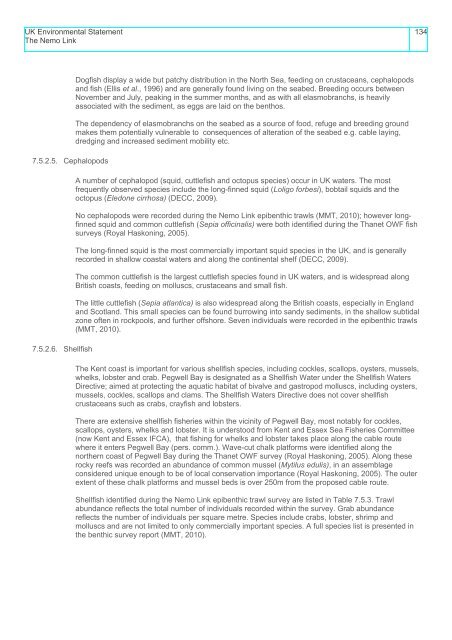Nemo-Link-UK-Marine-Environmental-Statement
Nemo-Link-UK-Marine-Environmental-Statement
Nemo-Link-UK-Marine-Environmental-Statement
Create successful ePaper yourself
Turn your PDF publications into a flip-book with our unique Google optimized e-Paper software.
<strong>UK</strong> <strong>Environmental</strong> <strong>Statement</strong>The <strong>Nemo</strong> <strong>Link</strong>1347.5.2.5. Cephalopods7.5.2.6. ShellfishDogfish display a wide but patchy distribution in the North Sea, feeding on crustaceans, cephalopodsand fish (Ellis et al., 1996) and are generally found living on the seabed. Breeding occurs betweenNovember and July, peaking in the summer months, and as with all elasmobranchs, is heavilyassociated with the sediment, as eggs are laid on the benthos.The dependency of elasmobranchs on the seabed as a source of food, refuge and breeding groundmakes them potentially vulnerable to consequences of alteration of the seabed e.g. cable laying,dredging and increased sediment mobility etc.A number of cephalopod (squid, cuttlefish and octopus species) occur in <strong>UK</strong> waters. The mostfrequently observed species include the long-finned squid (Loligo forbesi), bobtail squids and theoctopus (Eledone cirrhosa) (DECC, 2009).No cephalopods were recorded during the <strong>Nemo</strong> <strong>Link</strong> epibenthic trawls (MMT, 2010); however longfinnedsquid and common cuttlefish (Sepia officinalis) were both identified during the Thanet OWF fishsurveys (Royal Haskoning, 2005).The long-finned squid is the most commercially important squid species in the <strong>UK</strong>, and is generallyrecorded in shallow coastal waters and along the continental shelf (DECC, 2009).The common cuttlefish is the largest cuttlefish species found in <strong>UK</strong> waters, and is widespread alongBritish coasts, feeding on molluscs, crustaceans and small fish.The little cuttlefish (Sepia atlantica) is also widespread along the British coasts, especially in Englandand Scotland. This small species can be found burrowing into sandy sediments, in the shallow subtidalzone often in rockpools, and further offshore. Seven individuals were recorded in the epibenthic trawls(MMT, 2010).The Kent coast is important for various shellfish species, including cockles, scallops, oysters, mussels,whelks, lobster and crab. Pegwell Bay is designated as a Shellfish Water under the Shellfish WatersDirective; aimed at protecting the aquatic habitat of bivalve and gastropod molluscs, including oysters,mussels, cockles, scallops and clams. The Shellfish Waters Directive does not cover shellfishcrustaceans such as crabs, crayfish and lobsters.There are extensive shellfish fisheries within the vicinity of Pegwell Bay, most notably for cockles,scallops, oysters, whelks and lobster. It is understood from Kent and Essex Sea Fisheries Committee(now Kent and Essex IFCA), that fishing for whelks and lobster takes place along the cable routewhere it enters Pegwell Bay (pers. comm.). Wave-cut chalk platforms were identified along thenorthern coast of Pegwell Bay during the Thanet OWF survey (Royal Haskoning, 2005). Along theserocky reefs was recorded an abundance of common mussel (Mytilus edulis), in an assemblageconsidered unique enough to be of local conservation importance (Royal Haskoning, 2005). The outerextent of these chalk platforms and mussel beds is over 250m from the proposed cable route.Shellfish identified during the <strong>Nemo</strong> <strong>Link</strong> epibenthic trawl survey are listed in Table 7.5.3. Trawlabundance reflects the total number of individuals recorded within the survey. Grab abundancereflects the number of individuals per square metre. Species include crabs, lobster, shrimp andmolluscs and are not limited to only commercially important species. A full species list is presented inthe benthic survey report (MMT, 2010).


